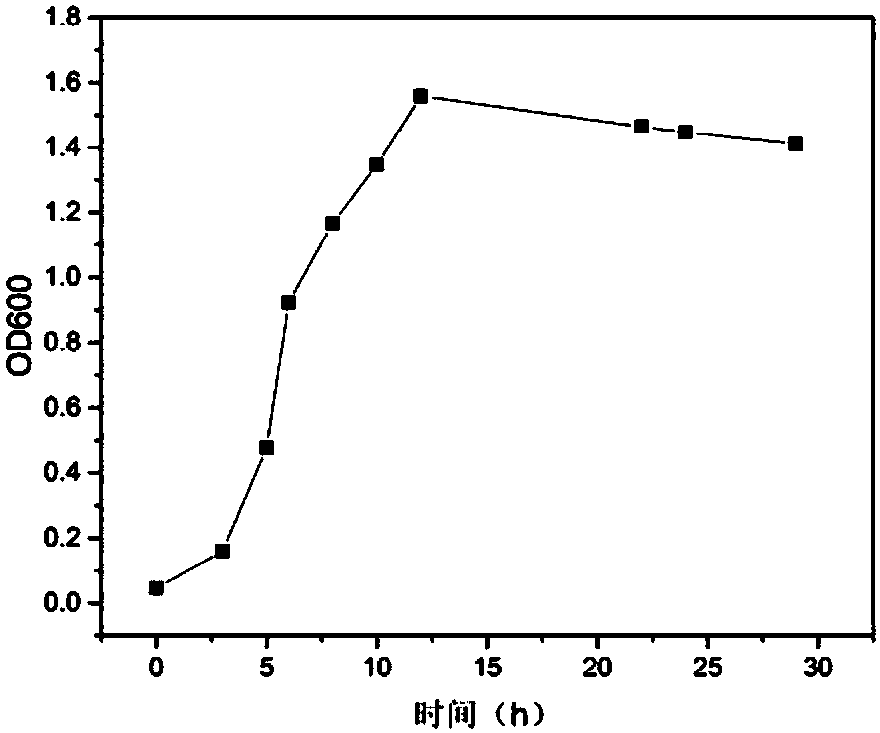2,4-dinitrotoluene sulfonate efficient degradation strain Microbacterium sp.X3 and application thereof
A technology of dinitrotoluenesulfonate and bacterial strains, applied in the field of environmental biology
- Summary
- Abstract
- Description
- Claims
- Application Information
AI Technical Summary
Problems solved by technology
Method used
Image
Examples
Embodiment 1
[0032] Example 1: Degradation Ability Determination of 2,4-Dinitrotoluenesulfonate Degrading Strain Microbacterium sp.X3
[0033] Take uncontaminated soil, air-dry and grind, pass through a 1mm sieve, and set aside. A certain amount of 2,4-DNT-3-SA and 2,4-DNT-5-SA was weighed and dissolved in acetone. In the fume hood, the acetone solution of the two sulfonates was evenly sprayed into the above soil and stirred evenly. The soil concentration was made approximately 500 mg / kg each of 2,4-DNT-3-SA and 2,4-DNT-5-SA; it was allowed to air dry naturally in a fume hood for 2 days.
[0034]A certain concentration of bacterial suspension was inoculated into the above soil according to the inoculum amount of 2%. As for culturing in a constant temperature incubator at 30°C, samples were taken every 24 hours, and the concentrations of 2,4-DNT-3-SA and 2,4-DNT-5-SA were measured by high performance liquid chromatography. The degradation curve is attached Figure 4 shown. It can be se...
Embodiment 3
[0035] Embodiment 3: Microbacterium sp.X3 is to the degradation effect of sulfonate at different pH values
[0036] Take uncontaminated soil, air-dry and grind, pass through a 1mm sieve, and set aside. A certain amount of 2,4-DNT-3-SA and 2,4-DNT-5-SA was weighed and dissolved in acetone. In the fume hood, the acetone solution of the two sulfonates was evenly sprayed into the above soil and stirred evenly. The soil concentration was made approximately 500 mg / kg each of 2,4-DNT-3-SA and 2,4-DNT-5-SA; it was allowed to air dry naturally in a fume hood for 2 days. Weigh 20 g of the above soil into a conical flask, and use dilute H 2 SO 4 and NaOH to adjust the pH of the soil to be 3, 5, 7, 9, 11 respectively, add the bacterium liquid activated by the Microbacterium sp.X3 of OD600=1 according to the inoculum size of 5%, and adjust the water-soil ratio with the inorganic salt liquid medium to be 2: 5. Seal with breathable parafilm. All the Erlenmeyer flasks were placed in a co...
Embodiment 4
[0038] Embodiment 4: Microbacterium sp.X3 is to the degradation effect of sulfonate at different temperatures
[0039] Take uncontaminated soil, air-dry and grind, pass through a 1mm sieve, and set aside. A certain amount of 2,4-DNT-3-SA and 2,4-DNT-5-SA was weighed and dissolved in acetone. In the fume hood, the acetone solution of the two sulfonates was evenly sprayed into the above soil and stirred evenly. The soil concentration was made approximately 500 mg / kg each of 2,4-DNT-3-SA and 2,4-DNT-5-SA; it was allowed to air dry naturally in a fume hood for 2 days. Weigh 20g of the above soil into an Erlenmeyer flask, add Microbacterium sp.X3 activated bacterial solution with OD600=1 according to 10% inoculation amount, adjust the water-to-soil ratio to 2:5 with an inorganic salt liquid medium, and seal it with a gas-permeable sealing film . The Erlenmeyer flasks were placed in constant temperature incubators at 15°C, 20°C, 25°C, 30°C, 35°C, and 40°C for a period of time, an...
PUM
 Login to View More
Login to View More Abstract
Description
Claims
Application Information
 Login to View More
Login to View More - R&D
- Intellectual Property
- Life Sciences
- Materials
- Tech Scout
- Unparalleled Data Quality
- Higher Quality Content
- 60% Fewer Hallucinations
Browse by: Latest US Patents, China's latest patents, Technical Efficacy Thesaurus, Application Domain, Technology Topic, Popular Technical Reports.
© 2025 PatSnap. All rights reserved.Legal|Privacy policy|Modern Slavery Act Transparency Statement|Sitemap|About US| Contact US: help@patsnap.com



